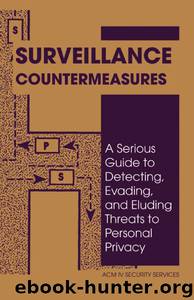Surveillance Countermeasures: A Serious Guide To Detecting, Evading, And Eluding Threats To Personal Privacy by ACM IV Security Services

Author:ACM IV Security Services [Unknown]
Language: eng
Format: epub
Tags: TRUE CRIME / Espionage
ISBN: 9781610047241
Publisher: Paladin Press
Published: 1994-03-01T08:00:00+00:00
CHAPTER 8
ACTIVE VEHICULAR SURVEILLANCE DETECTION
Active vehicular surveillance detection offers the Principal the greatest variety of detection maneuvers. During the follow phase of a surveillance operation, the team is in a reactive mode, dictated by the actions of the Principal. For a sophisticated surveillance team this is not a disadvantage because the operators are disciplined to react to virtually any maneuver in a systematic manner. It is only when the Principal maneuvers in a nonstandard manner that the surveillance team’s reactions are thrown out of synchronization. This complication forces the surveillance team to rely on resourcefulness rather than its planned tactical applications. Active surveillance detection is employed to force a surveillance asset to react in an unnatural manner when encountering an unanticipated maneuver by the Principal.
Active vehicular surveillance detection should be planned and should conform to the Principal’s established travel patterns. One travel pattern that enhances the ability to conduct surveillance detection is fast and aggressive driving. However, this should only be used if it conforms to the Principal’s normal pattern. A Principal who drives in a conservative manner on most occasions and then drives aggressively only when intending to conduct active surveillance detection sends an undesirable signal to a surveillance team. One reason fast and aggressive driving is an advantage is that it forces the surveillance team to drive in a similar manner. When the Principal is maneuvering through traffic aggressively, it is easy to observe to the rear for vehicles that are following in a similar manner.
In relation to aggressive driving, a Principal who establishes a pattern of using expedient shortcuts such as ducking into back streets or cutting through parking lots to avoid traffic signals has more flexibility in conducting surveillance detection maneuvers. Additionally, the Principal who establishes a pattern of violating traffic laws such as taking illegal left-hand turns or running red lights when no traffic is coming opens additional surveillance detection options. Such driving habits also serve the purposes of antisurveillance, which we will address in Chapter 12.
At the other extreme is slow and conservative driving. The Principal who drives in this manner inherits some surveillance detection advantages as well. Here too, if the Principal drives in a slow and conservative manner, the surveillance team is forced to conform to this pattern as well. If the Principal drives 5 miles per hour below the speed limit, he may upset a number of other vehicles, but he can easily isolate following vehicles that are maneuvering in a similar manner.
Driving patterns are used for detection purposes because a surveillance team will attempt to maintain mobile observation of the Principal from the rear. This requires that at least one surveillance vehicle maintain a following distance that is within observation range of the Principal but still provides a degree of security from detection. In most cases this will be dictated by the terrain and traffic obstacles. In open terrain such as on highways or rural state roads, a surveillance vehicle can increase the following distance because there is a greater
Download
This site does not store any files on its server. We only index and link to content provided by other sites. Please contact the content providers to delete copyright contents if any and email us, we'll remove relevant links or contents immediately.
The Brazilian Economy since the Great Financial Crisis of 20072008 by Philip Arestis Carolina Troncoso Baltar & Daniela Magalhães Prates(106355)
International Integration of the Brazilian Economy by Elias C. Grivoyannis(76041)
The Art of Coaching by Elena Aguilar(52218)
Flexible Working by Dale Gemma;(23213)
How to Stop Living Paycheck to Paycheck by Avery Breyer(19573)
The Acquirer's Multiple: How the Billionaire Contrarians of Deep Value Beat the Market by Tobias Carlisle(12119)
Thinking, Fast and Slow by Kahneman Daniel(11816)
The Radium Girls by Kate Moore(11642)
The Art of Thinking Clearly by Rolf Dobelli(9942)
Hit Refresh by Satya Nadella(8871)
The Compound Effect by Darren Hardy(8532)
Atomic Habits: Tiny Changes, Remarkable Results by James Clear(8058)
Tools of Titans by Timothy Ferriss(7834)
Turbulence by E. J. Noyes(7720)
Change Your Questions, Change Your Life by Marilee Adams(7394)
A Court of Wings and Ruin by Sarah J. Maas(7290)
Nudge - Improving Decisions about Health, Wealth, and Happiness by Thaler Sunstein(7264)
How to Be a Bawse: A Guide to Conquering Life by Lilly Singh(7167)
Win Bigly by Scott Adams(6840)
